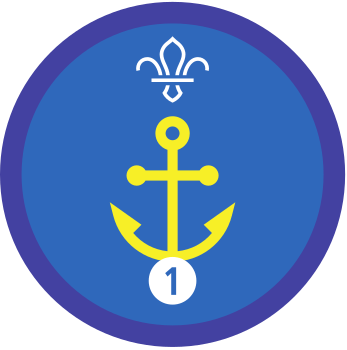
Traditional rafting
What to expect
Traditional rafting is about paddling along on a raft made from wooden poles, rope, and barrels. They’re simple crafts, so you’ll need to paddle a bit differently compared to how you’d paddle something like a canoe.
You often build your own raft before setting out on the water. Building your own raft is a really common pioneering activity, so get practising those knots and lashings.
What you’ll learn
Traditional rafting is a great way to try something new as traditional rafts are very different to other crafts. It’s also a true test of teamwork, as you’ll all need to play your part to get the raft moving in the right direction.
The best pioneering projects are the ones that are plenty of fun. Traditional rafting is about putting your knotting skills to the test and trusting your teammates’ techniques. After all, if it all falls apart, you’ll be the ones getting wet!
Fun facts
People have been building rafts for hundreds of years. The basic design involves tying things together to create a floating platform – more modern crafts tend to use sealed barrels or polystyrene blocks to help them float.
Handy hints
- Give it a go in the warm (and dry). Before you put your trust in a raft to carry you across the water, why not practise on a smaller scale? Teeny tiny twig rafts is the perfect way to learn how to make a raft before your adventure.
- Practise your knots. A raft is only as strong as its weakest knot. Before you put your skills to the test, make sure you know how to keep your raft shipshape. Scout Adventures have got your back – they’ve put together a great guide to lashings. Once you’ve learned the basics, make practising fun with Knot a race or To eat or knot to eat.
- Don’t wear your best shoes. When you sit on the raft, your feet will probably be in the water – whatever you’re wearing on your feet will get very soggy. It’s best to wear an old pair of shoes, and bring a spare pair to get you home.
Safety
You must always:
- Complete a risk assessment
- Have the right ratios of number of adults to provide suitable supervision
- Set up an InTouch process
- Know what to do in an emergency
- Share information with parents and carers with an activity information form
- Get approval from your Lead Volunteer.
Be safe outdoors:
- Check the weather forecast
Be safe in water:
Everyone should be able to swim 50 m wearing the clothing or equipment for the activity. Non-swimmers will need additional support.
Water can be dangerous - be aware of the risks.
The category of water depends on how safe the water is. Use our waterways directory to check.
Be sure to manage the group when near water, keeping everyone safe.
Make sure that all equipment is fit for purpose and in good condition:
Everyone must wear a life jacket or buoyancy aid.
The instructor must make sure boats are seaworthy.
There are regulations you must follow if you are hiring a boat.
Joint activities with other organisations:
- This activity can be run jointly with Girlguiding.
- This activity can be run with other organisations.
This activity can be led by you or someone else in Scouts:
The activity leader must have an adventurous activities permit with the right level and permissions for your group.
You don't need a permit for activities on Class C waters (safe, inland water less than 100 m wide).
Where the group is entirely members over the age of 18 the permit scheme does not apply, please follow the rule 9.8 adult groups.
You can go to a centre or use an activity leader who is not part of Scouting:
You must find a suitable provider who meets the following requirements:- The centre/instructor should hold one of these: (If the provider is AALA exempt)
- British Canoeing - Coach Award (level and discipline specific - with appropriate endorsements for the waters being used)
- Adventure Mark - centre
The provider must have public liability insurance.
Guidance
Reflection
Building (and paddling) a traditional raft relies on everyone playing their part. In the most successful teams, everyone has an important job to do. Did different people have different roles to keep the raft afloat and moving in the right direction? Did people have favourite (or least favourite) jobs?
How did people’s teams work – did everyone just get on with their jobs separately, or did they keep chatting and checking in with each other? The most successful team players put themselves in their teammates shoes so they can offer a helping hand and ask for help when they need it. Did anyone stand out as a great leader? How did they help everyone to make or paddle the raft?
Traditional rafting can often be adapted so more people can give it a go. You can adapt the shape and size of the raft. Many outdoor centres have facilities that cater for people with additional needs and experienced instructors to help everyone achieve their goals. Get in touch with your local provider to chat through the needs of people in your group – make sure you give them plenty of notice.
All Scout activities should be inclusive and accessible.
Rafting is a great way to put a pioneering project to the test and have fun on the water. What did people enjoy most about this activity? If they loved the crafting, you could try another pioneering project. If they loved being on the water, why not step it up and try white water rafting?





